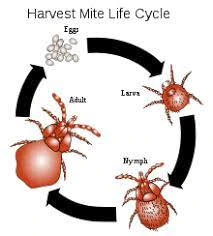Harvest mites, like spiders, are a microscopic member of the arachnid family. In the UK, the most common harvest mites in pets is the Trombicula autumnalis. Harvest mites are tiny and in small quantities pets may not even notice that they are there at all.
The problem occurs when the population of mite begins to grow. Interestingly however although they are small, with a keen eye you can spot mites before they become a problem.
Vet Know-how Tip: Mites are attracted to areas where the skin and coat is slightly thinner like paws, ears, the abdomen and groin. The tell-tale sign of harvest mites larvae are distinctive bright orange dots or orange dust-like clusters in these areas.
As mites breed and increase in numbers they become more active and often this is when we start to see clinical signs of a problem. These may include:
– Dermatitis (skin inflammation)
– Continuous rubbing, scratching or even biting to relieve the itch.
– Reddened skin patches.

Spotting the signs and getting help
As the “harvest” name suggests July and September are the most common times of year to get a mite infestation. If your dog is scratching continuously all of a sudden, mites may be the cause. However, this is not always the case as other ectoparasites and allergies such as pollen may show very similar clinical symptoms.
If you suspect something is not quite right it is important to get your pet examined by a veterinary professional. Diagnosis of mites is quite straightforward:
– Using sticky tape or removing hair a sample will be taken from the affected area.
– The sample will be examined under the microscope, to positively identify the harvest mite larvae.
– A course of treatment is then recommended.
Vet Know-how Tip: Harvest mites don’t always stick around so if you think your pet has them don’t delay in consulting your vet. When mites mature, they often hop off leaving no evidence that they were the cause of the skin damage and irritation to your pet. Naturally, being able to pinpoint the cause of the problem makes treatment simpler and often more effective.

Treatment
Knowing how to get rid of harvest mites will prove useful in the long run. Currently in the UK there are no licensed products for treating harvest mites in dogs or cats, however, there are treatments that can be prescribed by your vet that will kill them.
Spot-on treatments for fleas and ticks do not appear to kill harvest mites.
Effective treatment involves spraying the affected area completely to remove them. It may be that your vet will prescribe medication to help with any excessive itching especially if you pet is demonstrating signs of hypersensitivity to the harvest mite.
Vet Know-how Tip: Excessive itching damages the skin which can increase the risk of getting bacterial infections and other skin problems. Topical antibacterial agents and or antibiotics can be prescribed if necessary.
How do you avoid getting harvest mites?
– Walking dogs in the early morning or late evening – Larvae are only active during warm, dry days.
– Talk to other dog walkers and pick your walk carefully – Harvest mites are reported to be in very localised, meaning it is not uncommon to have masses of harvest mites in one field and none in the other.
– Avoid mite-prone areas – Long grasses and thick vegetation are common areas for harvest mites and other ectoparasites such as ticks, a lot of bad infestations are seen on dogs that rest or sit in prone areas on hot days.
– Vet Know-how Tip: During the summer walking at cooler times of day has other benefits, it can help prevent heat stroke, burnt foot pads as well reducing exposure to harvest mites.Can harvest mites affect humans
Unfortunately, harvest mites bite and feed on all warm-blooded animals so that includes us! Luckily however, it’s usually just an irritating bite on the feet, ankles, or lower legs that, although itch, can be treated with over-the-counter creams. It is, however, unlikely to find clusters of harvest mite larvae on humans as we don’t have hair like our pets to attach to.
Vet Know-how Tip: If you suffer from any reaction from bites it’s best to get it checked out with your GP. Please remember you must never use your medicine on your pet or theirs on yourself!
For other information on keeping your pets safe during the summer see: https://www.vetknowhow.co.uk/blog/summer-safety

